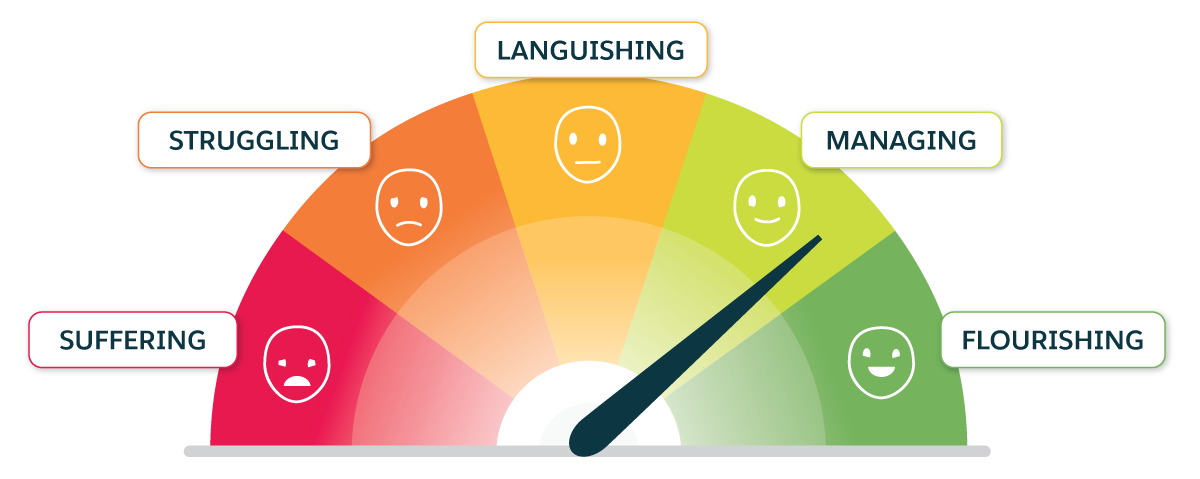Learn About the Mental Health Continuum
Learning Objectives
After completing this unit, you’ll be able to:
- Reframe mental health as part of overall health and wellbeing.
- Understand the phases of mental health on the mental health continuum.
Mental Health Is Part of Overall Health
Poor health can impact how we feel, work, and live. To take care of our physical health, we do things like exercise, eat foods that are good for us, try to get enough sleep, and have regular check-ups with our doctors. But it’s not just physical health that’s vital for our overall wellbeing. Mental health matters, too, and we need to take care of our mental health just like we do our physical health.
Mental health is a part of who we are. Physical and mental health contribute to our holistic wellbeing. As stressful times and concerns about health and work-life balance continue, it’s more important than ever to take care of our mental health.
At Salesforce, we know there are things we can do to strengthen and protect our mental health, build resilience, and better manage mental health challenges. We encourage our employees to do so, and we offer a number of resources to help.

To frame our conversation around mental health, we started by diving into the mental health continuum. There are a variety of ways to structure and describe this continuum. In this module, we offer the Salesforce version—which we’ve developed based on research from mental health experts and professionals, and feedback from our employees. In our continuum, mental health ranges from flourishing, considered the peak of wellbeing, to managing, languishing, struggling, and suffering.
People are resilient and designed to overcome adversity and bounce back. So, you might flow through the different phases as you experience life’s ups and downs. You can be anywhere on the continuum at any time.
As Salesforce President & Chief People Officer Brent Hyder said in a Mental Health Town Hall:
“You may be struggling, even suffering. You might feel energized today like me and inspired. You could be laughing or languishing… or somewhere in between. And this may change honestly day-to-day, or week to week… expect it as part of being a human being.”
Think of the continuum like a speedometer, tracking your speed as you drive down the highway of life. Ideally, you can set the cruise control to flourishing at whatever is a comfortable speed for you. Still, there are times you may need to use the accelerator or brakes due to internal and external factors, like when you feel anxious on an unknown road (internal) or a car accident slowdown (external).
Like a speedometer, your mental health can go from 0 (for example, languishing) to 80 (for example, flourishing) in 60 seconds. That’s why we encourage continually keeping an eye on where you are on the mental health continuum so you can course-correct and get back to cruise control when possible.

Let’s break down each phase of the Salesforce mental health continuum model in more detail.
1. Flourishing: When someone is flourishing, they’re at the peak of wellbeing. Life is great; they’re happy; they feel content in their current situation; and they feel connected to their relationships and future goals.
2. Managing: In the managing phase, individuals are equipped with the knowledge and skills to actively manage their thoughts, emotions, and behaviors. They have control of their mental health and are able to find their balance and peace. Individuals in this phase feel like they have the tools and resources to continue to build resilience and thrive.
3. Languishing: In this phase, things are neither good nor bad. Someone who is languishing is getting by but doesn’t feel especially excited about their lives or future. They may feel like they are stuck or idling. This is where the majority of individuals fall on the spectrum, with 55% of US employees languishing at any time.
4. Struggling: In this phase, individuals feel a bit hopeless, drained, and are not bouncing back from feelings of anxiety or depression.
5. Suffering: People in the suffering phase experience multiple, severe, and prolonged symptoms of mental illness such as irritability, difficulty concentrating, sleeping less or too much, becoming withdrawn, and/or low moods. These symptoms can result from many factors, including stressful events like losing a job or a traumatic incident like being involved in an automobile accident. But there can be other factors, like family history and chemical imbalances.
Remember, mental health is a part of being human. It reflects our emotional, psychological, and social wellbeing. Many of us will move along the continuum at different times in our lives. But when people find themselves staying too long in the Suffering phase, there are likely bigger issues at play—and they may be facing mental illness.
Mental health represents your overall state of mind–it's something that everyone should look after. Mental illness, however, is something disruptive to your mental state, and interrupts how you feel, think, communicate, and behave.
Let’s Sum It Up
We all have emotions, feelings, thoughts, and moods, no matter who we are or where we live. The World Health Organization states it best: “There is no health without mental health.” Everyone’s mental health falls on a continuum, and it’s important to continually check in on your mental health.
In the next unit, we evaluate why it’s so important to manage and address mental health issues.
Resources
- External Article: Anxiety Disorders (Association for Behavioral and Cognitive Therapies)
- External Article: Depression Fact Sheet (World Health Organization)
- External Article: There’s a Name for the Blah You’re Feeling (Adam Grant, New York Times)
- External Article: How Common Is PTSD in Adults? (U.S. Department of Veteran Affairs)
- External Article: PTSD Facts and Statistics (The Recovery Village)
- External Article: What is Post-Traumatic Stress Disorder? (American Psychiatric Association)
- External Article: What Is Mental Illness (American Psychological Association)
- External Article: The Causes of Mental Illness (National Center for Biotechnology Information)
- External Article: Anxiety Disorders Fact Sheet (Association for Behavioral and Cognitive Therapies)
- External Article: Not Ill, But Not Well. The Languishing of the "Massive Middle"